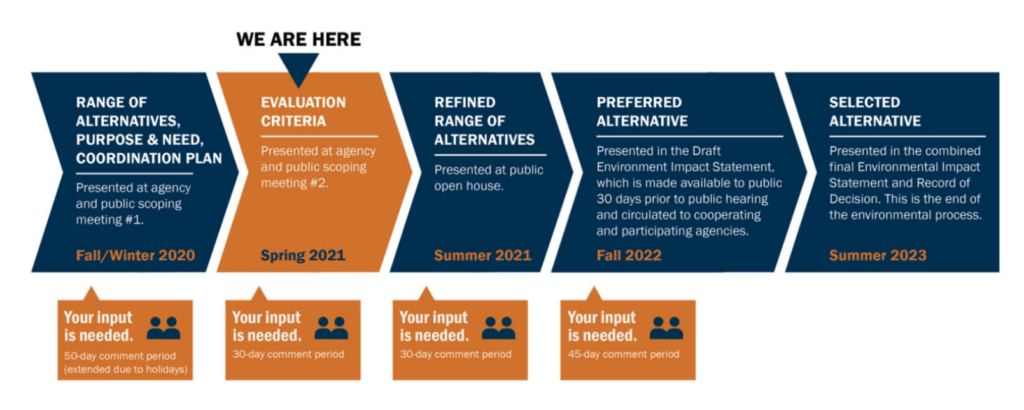TxDOT reveals early plans to accommodate I-35 caps
Monday, March 15, 2021 by
Jonathan Lee Discussion at Thursday’s City Council Mobility Committee meeting showed both the Texas Department of Transportation’s intent to accommodate caps over Interstate 35 and city leaders’ will to make it happen.
TxDOT said all three of the design alternatives for the proposed multibillion-dollar I-35 Capital Express Central project will allow caps – though TxDOT will not pay for them.
“We have determined that we will be environmentally clearing the right-of-way footprints with the caps in mind,” said Heather Ashley-Nguyen, TxDOT advance project development director. “In terms of locations, we’re still working on those.”
TxDOT’s project, which the agency says will improve traffic by adding two HOV lanes in each direction, would sink the I-35 main lanes between Lady Bird Lake and Airport Boulevard below the frontage road. Some alternatives show tunneled HOV sections.
The caps would allow the city to build parkland above the sunken freeway. Caps in other cities, such as Klyde Warren Park in Dallas, include amenities like lawns, sports fields, stages, cafes, playgrounds, splash pads, and food truck stalls. An urban boulevard concept – which some consider an upgrade from TxDOT’s typical frontage roads – could also be built over the caps.
But fully aligning city- and state-level priorities for the project will prove difficult. Council Member Paige Ellis, who chairs the committee, said, “We know that our seat as a City Council looks very different from TxDOT’s responsibility as the manager of this project, and that comes with different perspectives.” Ashley-Nguyen said the process will involve “give and takes.”
Ashley-Nguyen indicated that caps could fit along multiple stretches. “Right now, we’re looking between First and Fourth (streets) as a definite location,” she said, adding that several other locations for caps are being considered, including between Eighth and Ninth streets and 11th and 12th streets.
First, Ashley-Nguyen said, TxDOT needs to finalize “how to load and unload downtown from a traffic perspective. Based on that, it will determine the right-of-way footprints that will be needed for the cap.”
Though coordination between TxDOT and the city has been underway for some time, the city has not committed publicly to building the caps and has not identified funding sources. Corridor Program Office Director Mike Trimble is leading the city’s cap efforts, along with the Downtown Austin Alliance.
“I really appreciate the conversation about capping that still keeps coming up,” Mayor Pro Tem Natasha Harper-Madison said at Thursday’s meeting, “but I haven’t heard anybody talking numbers.” Ashley-Nguyen responded that Klyde Warren Park – similar in size to a cap between First and Fourth streets – cost around $100 million. The park was funded with both private and public money, including some from TxDOT.
TxDOT said many of the approximately 2,300 public comments it received during the project’s first scoping phase mentioned the caps. Several local groups, including Reconnect Austin, the Downtown Austin Alliance and the Urban Land Institute, have pushed for caps, arguing that they would go a long way toward stitching the divide between East and West Austin, which was caused in no small part by I-35.
In a tweet Saturday, Harper-Madison joined progressive advocates and urbanists to oppose the project on the whole.
The Urban Transportation Commission in December urged TxDOT not to expand the highway. ReThink 35, another advocacy group, favors removing I-35 through Central Austin and replacing it with an urban boulevard.
TxDOT, for its part, will push ahead. And barring any drastic measures – like the one taken by Houston and the federal Department of Transportation to pause TxDOT’s I-45 expansion – construction is set to start by 2025 and finish by the end of the decade.

The schedule for the next two years of the project
TxDOT is collecting public feedback on the plans between now and April 9 through a virtual scoping open house.
Rendering courtesy of the Urban Land Institute.
The Austin Monitor’s work is made possible by donations from the community. Though our reporting covers donors from time to time, we are careful to keep business and editorial efforts separate while maintaining transparency. A complete list of donors is available here, and our code of ethics is explained here.
You're a community leader
And we’re honored you look to us for serious, in-depth news. You know a strong community needs local and dedicated watchdog reporting. We’re here for you and that won’t change. Now will you take the powerful next step and support our nonprofit news organization?











